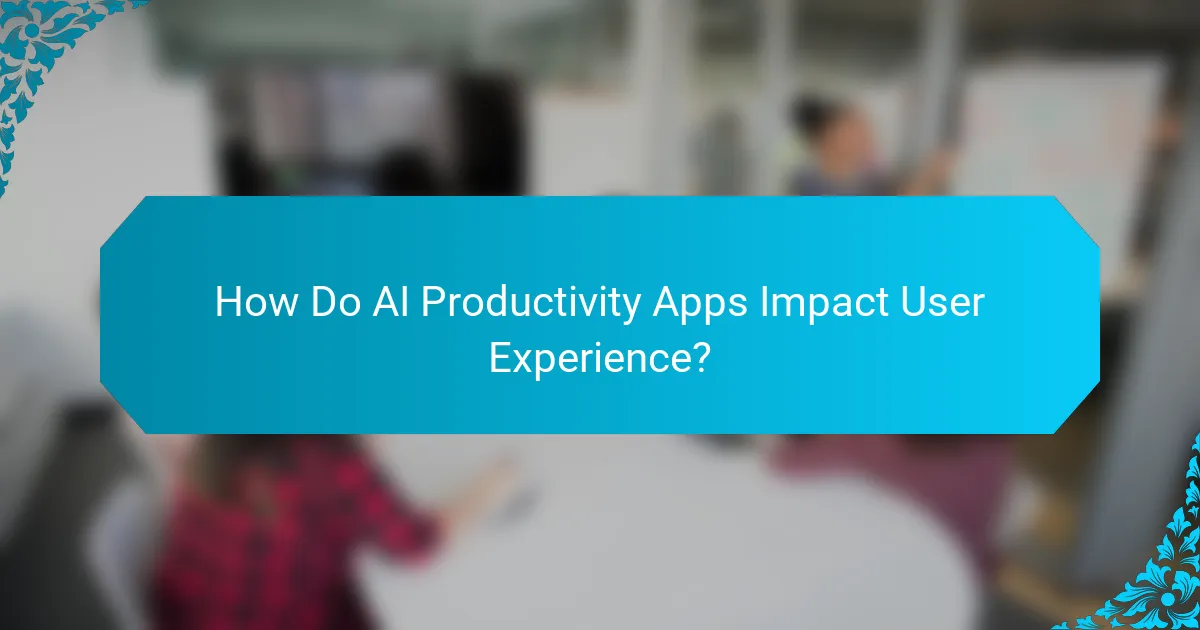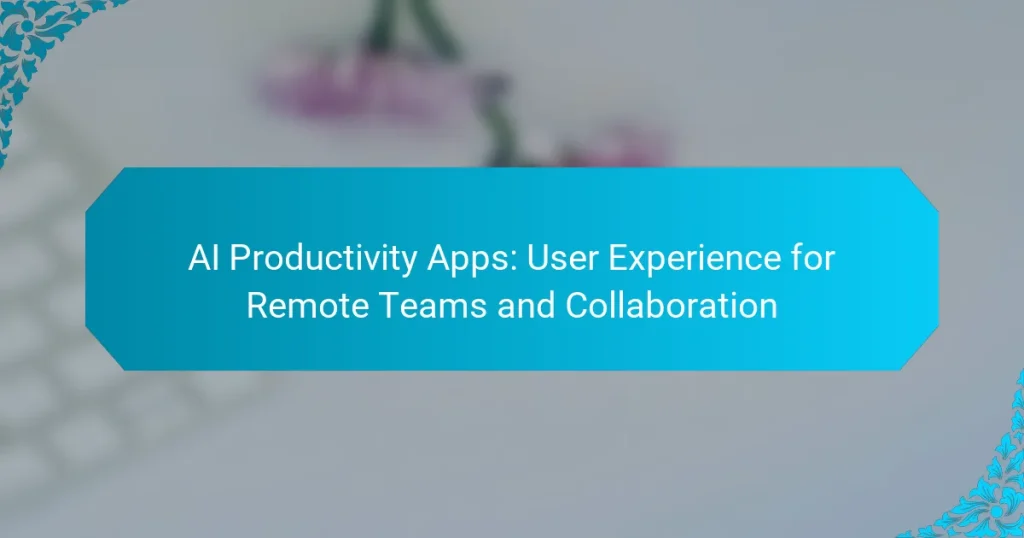AI productivity apps are revolutionizing the way remote teams collaborate by enhancing communication, automating repetitive tasks, and delivering real-time insights. By leveraging these tools, teams can work more efficiently, minimize misunderstandings, and create a cohesive work environment that fosters collaboration and productivity.

How Can AI Productivity Apps Enhance Remote Team Collaboration?
AI productivity apps can significantly enhance remote team collaboration by streamlining communication, automating tasks, and providing real-time insights. These tools help teams work more efficiently, reduce misunderstandings, and foster a more connected work environment.
Improved communication tools
AI productivity apps often include advanced communication features such as chatbots, voice recognition, and automated responses. These tools can help clarify messages and reduce response times, making it easier for team members to stay aligned.
For example, integrating AI-driven chatbots can provide instant answers to common queries, allowing team members to focus on more complex tasks. Additionally, tools that support video conferencing with AI enhancements can improve clarity and engagement during meetings.
Task automation features
Automation features in AI productivity apps can handle repetitive tasks, freeing up time for team members to concentrate on higher-value work. This can include automating scheduling, reminders, and even project updates.
For instance, an app might automatically assign tasks based on team members’ workloads and deadlines, ensuring that no one is overwhelmed. This not only boosts productivity but also helps maintain balance within the team.
Real-time collaboration capabilities
Real-time collaboration tools allow team members to work together seamlessly, regardless of their location. Features such as shared documents and live editing enable multiple users to contribute simultaneously, enhancing teamwork.
Using platforms that support real-time updates ensures that everyone is on the same page, reducing the risk of errors and miscommunication. This is particularly beneficial for remote teams that rely on quick feedback and iterative processes.
Data-driven insights for performance
AI productivity apps can analyze team performance data to provide actionable insights. These insights help identify bottlenecks, track progress, and suggest improvements based on historical data.
For example, an app might highlight which tasks are consistently delayed, allowing managers to address underlying issues. Leveraging these insights can lead to more informed decision-making and enhanced overall team performance.
Integration with existing tools
Effective AI productivity apps often integrate seamlessly with existing tools and platforms, creating a cohesive workflow. This integration minimizes disruptions and allows teams to leverage familiar systems while enhancing functionality.
For instance, integrating an AI app with project management software can streamline task tracking and reporting. Teams should evaluate potential integrations to ensure they align with their current processes and enhance productivity without adding complexity.

Which AI Productivity Apps Are Best for Remote Teams?
Several AI productivity apps stand out for enhancing collaboration among remote teams. Key options include Asana, Trello, Slack, Notion, and Microsoft Teams, each offering unique features tailored to different aspects of project management and communication.
Asana for project management
Asana is an effective tool for managing projects and tasks within remote teams. It allows users to create projects, assign tasks, set deadlines, and track progress visually, ensuring everyone stays aligned on goals.
To maximize Asana’s potential, utilize its timeline feature for planning and its reporting tools to monitor team performance. Be mindful of not overwhelming your team with too many tasks at once; prioritize and break down larger projects into manageable steps.
Trello for visual task tracking
Trello uses a card-based system to help teams visualize their workflow and task progress. Each card can represent a task, which can be moved across different stages of completion, making it easy to see what needs attention.
Consider using labels and due dates to enhance organization within Trello. A common pitfall is creating too many boards, which can lead to confusion; instead, keep boards focused on specific projects or teams.
Slack for team communication
Slack is a popular communication platform that facilitates real-time messaging and collaboration among remote teams. It offers channels for different topics, direct messaging, and file sharing, making it easy to keep discussions organized.
To improve communication efficiency, encourage the use of threads for specific conversations and integrate other tools like Google Drive or Asana for seamless access. Avoid using Slack for all communications; reserve it for quick updates and discussions to prevent information overload.
Notion for documentation and collaboration
Notion serves as an all-in-one workspace for documentation, project management, and collaboration. It allows teams to create wikis, databases, and notes, making it a versatile tool for storing and sharing information.
Leverage Notion’s templates to streamline setup for new projects or documentation. Be cautious of overly complex structures that can hinder usability; aim for simplicity and clarity in your organization to enhance team collaboration.
Microsoft Teams for integrated workflows
Microsoft Teams combines chat, video conferencing, and file sharing into a single platform, making it ideal for remote teams looking for integrated workflows. It seamlessly integrates with other Microsoft 365 applications, enhancing productivity.
To fully utilize Microsoft Teams, make use of its meeting scheduling and collaborative document editing features. Avoid cluttering channels with excessive messages; instead, create specific channels for different projects or teams to maintain focus and clarity.

What Features Should You Look for in AI Productivity Apps?
When selecting AI productivity apps, prioritize features that enhance collaboration and streamline workflows for remote teams. Key aspects include user-friendly interfaces, customizable workflows, robust security measures, and scalability to accommodate team growth.
User-friendly interface
A user-friendly interface is crucial for ensuring that all team members can navigate the app with ease. Look for apps that offer intuitive design, clear navigation, and minimal learning curves. Features like drag-and-drop functionality and customizable dashboards can significantly enhance user experience.
Consider apps that provide tutorials or onboarding processes to help new users familiarize themselves quickly. A well-designed interface can reduce frustration and increase overall productivity, making it easier for teams to collaborate effectively.
Customizable workflows
Customizable workflows allow teams to tailor the app to their specific processes and needs. Look for features that enable users to create, modify, and automate tasks according to their unique requirements. This flexibility can lead to improved efficiency and better alignment with team goals.
Apps that support integration with other tools and platforms can further enhance customization. For example, being able to connect with project management software or communication tools can streamline operations and reduce the need for switching between applications.
Robust security measures
Robust security measures are essential for protecting sensitive data, especially for remote teams that may handle confidential information. Look for apps that offer end-to-end encryption, secure user authentication, and compliance with data protection regulations like GDPR or CCPA.
Regular security updates and transparent privacy policies are also important. Ensure that the app provides features like user access controls and activity logs to monitor and manage data security effectively.
Scalability for growing teams
Scalability is vital for teams anticipating growth. Choose AI productivity apps that can easily accommodate an increasing number of users and projects without compromising performance. This includes features like tiered pricing plans that allow you to upgrade as your team expands.
Evaluate whether the app can handle larger data volumes and more complex workflows as your team grows. A scalable solution will save time and resources in the long run, allowing teams to focus on their core tasks without being hindered by software limitations.

How Do AI Productivity Apps Impact User Experience?
AI productivity apps significantly enhance user experience by streamlining workflows and automating repetitive tasks. This leads to a more efficient collaboration environment for remote teams, allowing members to focus on high-value activities.
Reduction in task completion time
AI productivity applications can reduce task completion time by automating routine processes and providing intelligent suggestions. For instance, tools that analyze user behavior can prioritize tasks or offer shortcuts, resulting in time savings of up to 30% in some cases.
To maximize efficiency, teams should identify repetitive tasks that can be automated. Regularly reviewing workflows and integrating AI solutions can help pinpoint areas for improvement, ensuring that team members spend less time on mundane activities.
Increased user engagement
AI-driven tools can boost user engagement by personalizing experiences and providing real-time feedback. Features such as adaptive learning and smart notifications keep users informed and motivated, leading to higher participation rates in collaborative projects.
To foster engagement, teams should utilize AI features that encourage interaction, such as gamification elements or collaborative brainstorming sessions. Regularly updating these tools based on user feedback can further enhance the overall experience and maintain high levels of engagement.


